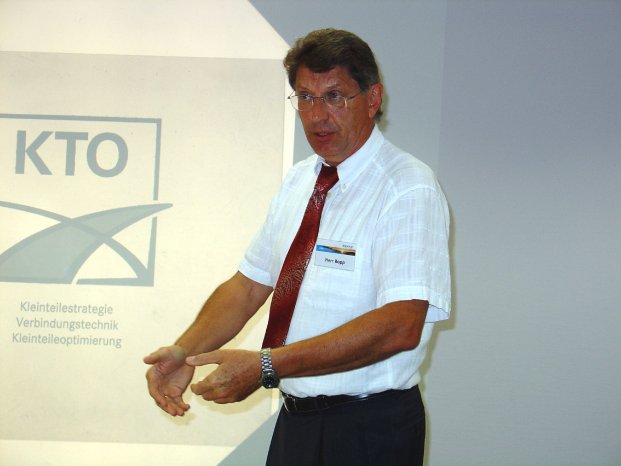Reinhard Barth, Product Manager at Arnold Umformtechnik, takes up the story: "Smaller companies could do what a big company such as Daimler is doing even more effectively," he said encouragingly. According to him only 8% of the cost of a screw fastening is down to the cost of the part itself. Over 50% of the cost is taken up with the preparation work such as drilling or tapping, 20% in staff costs, and a further 8% in tool costs. The objective must therefore be to reduce the system costs: "Only by looking at a fastening as a whole can effective cost savings be made." Barth mentioned some examples: A manufacturer of lamps increased its order for fasteners by 30% over the previous year, yet paid only 13% more for them. They managed to do this by drastically cleaning up the assortment of articles: This meant a reduction in the number of materials supplied from 54 to 30, and so the average unit price fell by 14%. The same thing happened for a car seat manufacturer: With the help of Arnold Umformtechnik, they saved at least 250,000 euro, by improving their joining technology, introducing logistics concepts such as consignment storage and Kanban, and cutting out 13 reference items. There is just as much savings potential in the company's self-tapping screws, which when screwed into a core hole, form their own nut thread. DaimlerChrysler is already using this type of screw in 50% of its applications. Arnold Umformtechnik offers Taptite 2000, which, with its improved thread geometry, is able to apply preload forces with almost the same process reliability as metric screws. Product Manager Thomas Jakob explains the savings effects that can be achieved in another example, showing a cost analysis made by Mahle Filter Systems GmbH of Stuttgart. The Mahle study assumes pre-cast core holes and comes to the following conclusion: A Taptite 2000 can reduce the manufacturing costs for an automatically fitted screw fastening by up to 80%, and that of a manually fitted fastening by up to 65%.
The Untertürkheim model makes noises as far away as Japan.
Reinhard Barth, Product Manager at Arnold Umformtechnik, takes up the story: "Smaller companies could do what a big company such as Daimler is doing even more effectively," he said encouragingly. According to him only 8% of the cost of a screw fastening is down to the cost of the part itself. Over 50% of the cost is taken up with the preparation work such as drilling or tapping, 20% in staff costs, and a further 8% in tool costs. The objective must therefore be to reduce the system costs: "Only by looking at a fastening as a whole can effective cost savings be made." Barth mentioned some examples: A manufacturer of lamps increased its order for fasteners by 30% over the previous year, yet paid only 13% more for them. They managed to do this by drastically cleaning up the assortment of articles: This meant a reduction in the number of materials supplied from 54 to 30, and so the average unit price fell by 14%. The same thing happened for a car seat manufacturer: With the help of Arnold Umformtechnik, they saved at least 250,000 euro, by improving their joining technology, introducing logistics concepts such as consignment storage and Kanban, and cutting out 13 reference items. There is just as much savings potential in the company's self-tapping screws, which when screwed into a core hole, form their own nut thread. DaimlerChrysler is already using this type of screw in 50% of its applications. Arnold Umformtechnik offers Taptite 2000, which, with its improved thread geometry, is able to apply preload forces with almost the same process reliability as metric screws. Product Manager Thomas Jakob explains the savings effects that can be achieved in another example, showing a cost analysis made by Mahle Filter Systems GmbH of Stuttgart. The Mahle study assumes pre-cast core holes and comes to the following conclusion: A Taptite 2000 can reduce the manufacturing costs for an automatically fitted screw fastening by up to 80%, and that of a manually fitted fastening by up to 65%.

